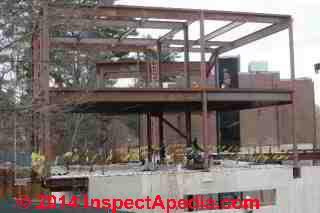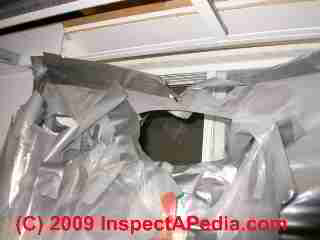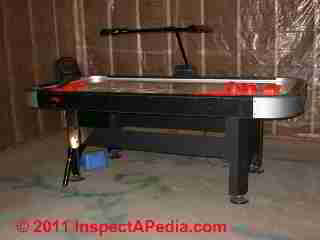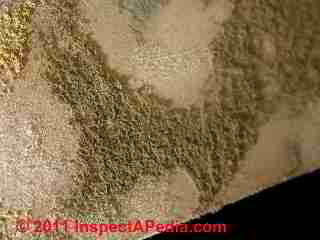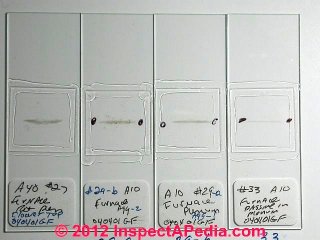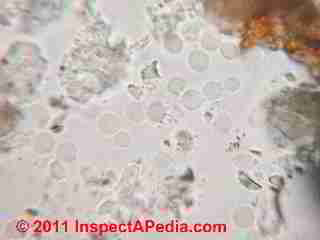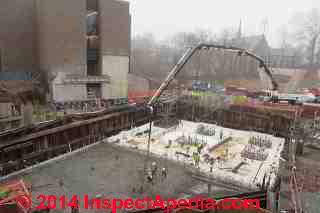 Indoor Air Quality During Construction
Indoor Air Quality During Construction
Building IAQ & IEQ Resources, Procedures & Sources of Errors
- POST a QUESTION or COMMENT about indoor environmental hazards associated with building construction, renovation, repair
IAQ and IEQ during construction & renovation or building cleaning operations:
This article describes the common indoor environmental issues for occupied buildings during construction, renovation, or remodeling and for occupied buildings adjacent to and impacted by such construction projects. We provide references to authoritative information sources giving advice on management of indoor air quality and the indoor environment for construction environments.
Our page top photograph illustrates a large construction project underway on the Vassar College campus in Poughkeepsie, New York in 2013. A new sciences building is under construction on a job site placing major building activity adjacent to an occupied academic building.
InspectAPedia tolerates no conflicts of interest. We have no relationship with advertisers, products, or services discussed at this website.
- Daniel Friedman, Publisher/Editor/Author - See WHO ARE WE?
Managing IAQ and IEQ during construction projects
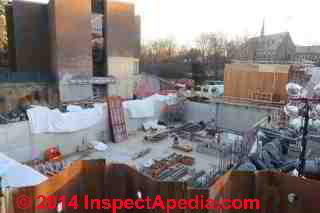 Writing in a recent issue of The Synergist, a publication of the American Industrial Hygiene Association, Weekes, Baker and Springston (2004) describe the range of indoor environmental contaminants that may affect the quality of the indoor envrionment during construction, including airborne particles, VOCs, and in some cases biological contaminants such as mold spores.
Writing in a recent issue of The Synergist, a publication of the American Industrial Hygiene Association, Weekes, Baker and Springston (2004) describe the range of indoor environmental contaminants that may affect the quality of the indoor envrionment during construction, including airborne particles, VOCs, and in some cases biological contaminants such as mold spores.
[Click to enlarge any image]
Any of these can result in IAQ complaints by building occupants ranging from skin irritation to respiratory or other health complaints and potentially respiratory distress, particularly for people at extra risk such as asthmatics.
After citing a number of useful resources (listd below), those authors quoted maximum concentration levels cited in LEEDv4 from the U.S. Green Building Council (USGBC). That list expands upon the particulate irritants described above to include potentially troublesome contaminants such as carbon monoxide (CO), Formaldehyde, VOCs, Ozone, as well. The USGBC document describes both recommended maximum concentrations of these contaminants and the test methods used to evaluate their levels in a building.
What are the Common Indoor Hazards Arising During Construction?
To address these potential hazards during a construction project the job managers are invited to prepare and follow an Indoor Air Quality (IAQ) management plan that specifies various control measures such as
- Controlling the contaminant sources
- Interrupting the pathways by which contaminants enter the building
- Protecting the building HVAC system from contamination
- Cleaning & housekeeping activities
- Construction work scheduling
- Occupant relocation
As steel construction continues atop the concrete foundation and walls of this new building underway adjacent to an occupied building (background in my photo), processes include grinding, cutting, and welding operations that may add to airborne particulates.
Where do the SNAFUs Occur during Indoor Environmental Quality Management During Construction or Remediation?
I suspect that whether we are monitoring indoor building conditions during construction or before, during and after an asbestos or mold remediation project, among these measures, failures in IEQ management and monitoring usually occur in these areas:
- Dust containment failures: the original containment barriers are incomplete, poorly constructed, or collapse, fail, or are moved for expedient needs during the construction project. Cross-contamination between the work area and other building areas has often led to a subsequent need for additional cleaning.
While the use of air handling and ventilation equipment to create effective air pressure differences between building areasis a key step in controlling the indoor environment during construction, I often find cases of mis-use of "air scrubbers".
Often there seems to be a fantasy that an air filtering machine can remove a problem source from a building. This common SNAFU is about as effective as imagining that we can stand in the kitchen and wave our home vacuum cleaner wand in the air to remove dust bunnies from under the living room couch. - HVAC protection failures: the HVAC system is operated when it should not be, such as before and during mold remediation work, becoming contaminated, distributing contaminants to other building areas, and requiring additional cleaning of both the HVAC system and the affected areas as a result.
- Occupant relocation: in a few cases I've encountered occupants who were in my opinion at very high risk (elderly, immune impaired, asthmatic) who were left in high risk areas or even in visibly contaminated areas of homes.
In a particularly egregious case I inspected a rental home in which an elderly occupant was asthmatic, on continuing oxygen and breathing apparatus, wheelchair-bound, and was sitting in a room where there was extensive visible mold contamination, predominantly Aspergillus versicolor and A. niger, small but harmful particles that are easily inhaled deeply into the lungs.
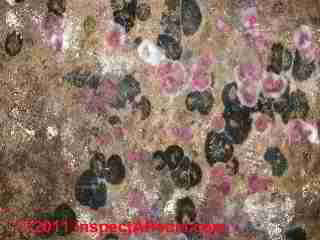
- Crypto-contaminants: among several thousand inspections and tests of mold-contaminated buildings I found that in many cases the visible mold that had alarmed building owners or occupants was the "tip of an iceberg" of a much larger mold reservoir that was less visually obvious (mold or dust-contaminated insulation, carpets, soft goods) or that was hidden entirely (an extensive mold colonization inside of building wall cavities, often on the cavity side of drywall).
The photograph at left illustrates mold contamination I found inside of a wall cavity in a building that had already been "mold remediated" by a water damage and mold cleanup company who used a "water extraction" method" to dry out the building.
One might infer that the method used was not as successful as we'd have hoped. - Indoor Environmental Contaminant Test & Inspection Inadequacies: the single most common complaint I have observed among a very large number of readers of our online information about indoor environmental contaminants and IEQ complaints is the casual use of what I consider superficial testing without an adequate building inspection and without adequate interviews.
Too often a purported "expert" conducts an air test for a contaminant, sends the test sample to a test laboratory, and leaves the building owners and occupants with virtually no useful information.
In my experience, which is principally with particulate contaminants, the tests used by some investigators and the reports of those results completely fail to acknowledge a stunning range of test variability that arises from even small changes in test conditions.
Turning a fan on or off, opening or closing a window, or running the ventilation system produce huge differences in the degree to which particulates are airborne. But some less obvious variations in test conditions can still produce several orders of magnitude difference in the detection of indoor contaminants. I have conducted in parallel and in-series tests of airborne particle detection methods to explore these variations.
Some examples of air test result variation sources & effects include
Image above: four air samples of airborne particulates in the same location lay down four very different particle traces, illustrating, even to the naked eye, that very different particle levels may be detected depending only on distrubances during the sampling interval.
Yet almost no field practitioner documents these conditions or variables during testing.
[Click to enlarge any image]
- A room empty of occupants tests very differently than one that is occupied
- Simply relocating the air sampling appliance at different heights above a floor or at different proximitiy a problem source produces one to three orders of magnitude difference in the detection of some particles. My two photos above show mold contamination on the under-side of a pool table. Placing my Burkard PAS air sampler on the floor under the table, atop the table, and at head-height in the room (about 6 feet over the floor) gave three significantly different particle level results. Waving a notebook at the table top or having someone walk by the table during testing changed the results again.
- Changes in indoor humidity level produces orders of magnitude difference in the detection of certain indoor spore counts for fungi that vary in spore release as a function of humidity, or temperature, or both
- Waving my notebook in the air in a room during an air test can alone change the airborne particle count by one to three orders of magnitude.
- Tapping on the side of an air handler or HVAC duct during airborne particle tests can change the level of detection of particles from an incidental or rare particle occurrence to very high levels of particle occurrence in building air.
- Tape sampling of moldy surfaces is an appealing test strategy if there is justification for genera/species identification in the first place. But everything depends on where you press the tape. In a mold-contaminated building we rarely find that only one genera/species of mold growth is present.
At MOLD APPEARANCE on VARIOUS SURFACES I include photographs illustrating that we find completely different mold genera/species growing on the edge of a hollow-core luan interior door than on the door surface - these are two different wood species subjected to othewise the identical indoor (and mold-contaminated) environment. - More of these factors are discussed in detail at ACCURACY OF AIR TESTS for MOLD and at AIRBORNE PARTICLE COUNT VARIATION CAUSES
- Mold culture tests: Really? Even less reliable in my opinion is the widespread use of culture plates to "test for mold" in buildings. Since 90% of molds won't grow on any culture whatsoever, and since even among those that will grow on a culture some genera/species will overgrow others on the culture plate independent of their original frequency in air, and as particles settle out of air at different rates depending in part on particle mass, this is a rather unreliable approach. See details at MOLD CULTURE TEST KIT VALIDITY.
A result of the failure to understand these very large impacts on building envronmental testing is that there is a great deal of confusion between accuracy of test results and the precision with which the results are stated. A mold test lab report may indicate that there wer 3478 Aspergillus sp. spores per M3 of air in a test space - a misleadingly precise number - while my tests of particulate variability have indicated that the accurate number can actually range between about 300 spores /M3 and 3,000,000 spores /M3!
Low mold counts & False Negatives:
On occasion, particularly when a mold test was conducted in an area a bit distant from a problematic mold reservoir in a building a very low mold count may mask a significant mold contamination problem. The photo at left shows about 20 Aspergillus sp. spores - the only ones present in this sample.
Reporting an indoor count of 20 Pen/Asp spores per M3 of air in a test space would lead most experts to opine that there is no mold contamination problem in the building, claiming that the low mold spore count may be conistent with spore levels in outdoor air - a view that can have merit.
But my interpretation of this image is different. The occurrence of these spores in chains and in a cluster suggests that there is or was a nearby active-growth Aspergillus sp. mold colony. Aspergillus sp. spore chains are quite fragile and break apart quickly in air. Finding these spores still bonded in a chain means that there was a reservoir nearby - these spores didn't come in through the window.
In my view this means that there is a significant chance of a false-negative conclusion when screening the indoor environment for airborne particulates and possibly for chemicals as VOCs as well. (See ACCURACY vs PRECISION of MEASUREMENTS).
Importance of effective building inspection & occupant interviews for contaminant sources
In effect, too often either the indoor contaminant test was itself inadequate as a building screen for a hidden problem, or even if the test found indications of an actionable problem, the consultant and test failed to give useful information about what action is needed, failing to answer questions such as Where is the problem source? and What caused it? and How much cleaning is needed?
A strategy of thorough visual inspection, taking of the building's leak history, occupant complaints, and an understanding of building construction, where leaks or moisture traps occur, and what materials are most conducive to problematic mold growth, insect infestation, or probable prior use of chemicals such as pesticides can help find these less obvious indoor contaminant sources before as well as during a construction project so that appropriate containment or other measures can be established.
Useful References for Building Indoor Air Quality and Indoor Environmental Quality During Construction
Weekes et als, (2014) suggested some of these construction IAQ IEQ resources while others are cited from the U.S. EPA IAQ Design Tools for Schools web page.
- ASHRAE, "Indoor Air Quality Guide: Best Practices for Design, Construction and Commissioning" [download link], ASHRAE Headquarters, 1791 Tullie Circle, N.E. Atlanta, GA 30329 Website: https://www.ashrae.org/
- CCA, "Mould Guidelines for the Canadian Construction Industry", Standard Construction Document CCA 82-2004, Canadian Construction Association,
400-75 Albert Street,
Ottawa, ON K1P 5E7 Canada,
Tel: (613) 236-9455 Fax: (613) 236-9526
www.cca-acc.com, retrieved 4/22/14, original source: http://www.cca-acc.com/documents/cca82/cca82.pdf - Donald Weekes, Wayne A. Baker, Jack Springston, "Resources for Managing IAQ during Construction", The Synergist, April 2014, p. 27-30, American Industrial Hygiene Association (AIHA), AIHA,
3141 Fairview Park Drive, Suite 777
Falls Church, VA 22042, Website: https://www.aiha.org Email: infonet@aiha.org , Tel: 703-849-8888. - EPA, "IAQ Design Tools for Schools", U.S. Environmental Protection Agency, http://www.epa.gov/iaq/schooldesign/construction.html
- "Maintaining Indoor Environmental Quality (IEQ) during Construction and Renovation" [PDF], NIOSH, http://www.cdc.gov/niosh/topics/indoorenv/constructionieq.html
- Minnesota Sustainable Design Guide - www.sustainabledesignguide.umn.edu/
- City of New York, "High Performance Building Guidelines", April, 1997, city of New York, Department of Design and Construction www.nyc.gov/html/ddc/downloads/pdf/high_build_guide/BuildGuide.pdf (PDF, 146 pp., 2.21 M)
- SMACNA, "IAQ Guidelines for Occupied Buildings Under Construction", 2nd Ed., (2007), Sheet Metal and Air Conditioning Contractors' National Association, 4201 Lafayette Center Drive Chantilly, Virginia 20151-1219, Tel (703) 803-2980 - Fax (703) 803-3732, Website: http://www.smacna.org/
Excerpt from the documents Forward:
The IAQ Guideline is intended to be an authoritative source for providing project management guidance in maintain- ing satisfactory indoor air quality (IAQ) of occupied buildings undergoing renovation or construction. The Guideline covers how to manage the source of air pollutants, control measures, quality control and documentation, communica- tion with occupants. It includes example projects, tables, references, resources, and checklists. The previous edition of the IAQ Guideline is referenced by the U.S. Green Building Council’s LEED Green Building Rating System for Existing Buildings and New Construction. SMACNA recommends the guide to architects, engineers, construction managers, facility managers and building owners who will be involved in construction activities inside occupied build- ings. Additionally, the principles presented here are also applicable to IAQ problems encountered in occupied areas of buildings during the final phases of new construction. - U.S. Green Building Council, "Reference Manual for LEED Green Building Rating System (Commercial, Version 2)", U.S. Green Building Council, 2101 L Street NW, Suite 500, Washington D.C. 20037, USA, Tel: 800-795-1747, Website: www.usgbc.org
...
Continue reading at DUST ANALYSIS for FIBERGLASS or select a topic from the closely-related articles below, or see the complete ARTICLE INDEX.
Suggested citation for this web page
CONSTRUCTION IAQ IEQ found at InspectApedia.com - online encyclopedia of building & environmental inspection, testing, diagnosis, repair, & problem prevention advice.
Or see this
INDEX to RELATED ARTICLES: ARTICLE INDEX to BUILDING INDOOR AIR QUALITY IAQ
Or use the SEARCH BOX found below to Ask a Question or Search InspectApedia
Ask a Question or Search InspectApedia
Try the search box just below, or if you prefer, post a question or comment in the Comments box below and we will respond promptly.
Search the InspectApedia website
Note: appearance of your Comment below may be delayed: if your comment contains an image, photograph, web link, or text that looks to the software as if it might be a web link, your posting will appear after it has been approved by a moderator. Apologies for the delay.
Only one image can be added per comment but you can post as many comments, and therefore images, as you like.
You will not receive a notification when a response to your question has been posted.
Please bookmark this page to make it easy for you to check back for our response.
IF above you see "Comment Form is loading comments..." then COMMENT BOX - countable.ca / bawkbox.com IS NOT WORKING.
In any case you are welcome to send an email directly to us at InspectApedia.com at editor@inspectApedia.com
We'll reply to you directly. Please help us help you by noting, in your email, the URL of the InspectApedia page where you wanted to comment.
Citations & References
In addition to any citations in the article above, a full list is available on request.
- Donald Weekes, Wayne A. Baker, Jack Springston, "Resources for Managing IAQ during Construction", The Synergist, April 2014, p. 27-30, American Industrial Hygiene Association (AIHA)
- [1] U.S. Army Field Manual FM-8-285-Noxious_Chemicals discusses Ammonia, Carbon Monoxide, Hydrogen Sulfide, Oxides of Nitrogen, Hazards caused by fire
- [2] Gregory Brown, P.E., Eastern Environmental Engineering Services, Califon NJ, Tel: 908-832-5098, Email: gabrown48@comcast.net. Mr. Brown, a licensed professional engineer in New Jersey and Pennsylvania, provides environmental / compliance, investigation, and remediation services and is the contributor of ENVIRONMENTAL REGULATIONS, New Jersey - Update on New Jersey Environmental Regulations that impact real estate transactions.
- [3] "Arts and Crafts, an Industrial Hygiene Challenge", Monona Rossol, The Synergist, May 2012, pp. 34-37American Industrial Hygiene Association.
- [4] Encyclopedia of Toxicology, 2d Ed., Bruce Anderson (Editor) eta als, Academic Press, ISBN-10: 0127453547, ISBN-13: 978-0127453552 - Quoting:
The second edition of the Encyclopedia of Toxicology continues its comprehensive survey of toxicology. This new edition continues to present entries devoted to key concepts and specific chemicals. There has been an increase in entries devoted to international organizations and well-known toxic-related incidents such as Love Canal and Chernobyl. Along with the traditional scientifically based entries, new articles focus on the societal implications of toxicological knowledge including environmental crimes, chemical and biological warfare in ancient times, and a history of the U.S. environmental movement.
With more than 1150 entries, this second edition has been expanded in length, breadth and depth, and provides an extensive overview of the many facets of toxicology.
Also available online via ScienceDirect - featuring extensive browsing, searching, and internal cross-referencing between articles in the work, plus dynamic linking to journal articles and abstract databases, making navigation flexible and easy. For more information, pricing options and availability visit www.info.sciencedirect.com. - [5] Encyclopedia of Toxicology, Chemicals & Concepts, Philip Wexler (Editor), Academic Press, 1998, ISBN-10: 012227220X,
ISBN-13: 978-0122272202 - Quoting:
The Encyclopedia of Toxicology provides a comprehensive collection of concise and readable explanations of basic principles in toxicology and the potential hazards of chemicals. Written by highly qualified contributors and containing a broad selection of topics, the Encyclopedia of Toxicology is of value to both toxicologists and non-toxicologists, including physicians, attorneys, regulators, safety managers, and environmental engineers-anyone whose work involves the health and safety issues of common and uncommon substances. The Encyclopedia of Toxicology plays a critical role at the intermediate level by offering more detail than a dictionary while remaining accessible to the generalist in risk assessment, regulation, and consulting. The Encyclopedia includes entries related to research and clinical toxicology, risk assessment, ecotoxicology, epidemiology, radiation, noise, information resources, organizations, and education. With more than 750 entries, extensive cross-references, a detailed index, and numerousreferences to primary and secondary literature, the Encyclopedia will be an indispensable resource. - [6] Encyclopedia of Clinical Toxicology: A Comprehensive Guide to the Toxicology of Prescription and OTC Drugs, Chemicals, Herbals, Plants, Fungi, Marine ... Clothing and Environmental Toxins, Irving S. Rossoff, Informa Healthcare, 2001, ISBN-10: 1842141015, ISBN-13: 978-1842141014 - Quoting:
An encyclopedic guide to the physical properties and symptomatology, this book describes adverse effects and interactions often not reported by manufacturers and not published in PDRs and the other standard compendia. It is compactly written and easy to read, designed for quick reference and retrieval of vital information about the effects, interactions, and lethal doses of thousands of toxic substances that can destroy health, seriously endanger health, or cause death, and that are in many cases documented nowhere else. An exceptionally complete word index of some 100 pages helps readers locate any topic by reference to substance headings, which are organized A-Z in the text. - [7] Arts, Crafts, & Theater Safety (ACTS), 181 Thompson Street, #23
New York, NY 10012-2586
Telephone: (212) 777-0062
E-Mail: ACTSNYC@cs.com, web search 5/9/12, website: http://www.artscraftstheatersafety.org/ - Quoting:
ACTS is a not-for-profit corporation that provides health, safety, industrial hygiene, technical services, and safety publications to the arts, crafts, museums, and theater communities. A part of the fees from our consulting services goes to support our free and low-cost services for artists. We gratefully accept donations, but do not solicit them from the artists who call here for help and advice. We recognize that artists and performers are among the least affluent groups in society. ACTS also will not accept money or take advertising in our publications from manufacturers of artists materials or businesses whose interests could conflict with ours. We want artists to know that we have no financial incentive to make our product and safety recommendations. - [8] The Artist's Complete Health and Safety Guide, Monona Rossol, Allworth Press, 2001, ISBN-10: 1581152043
ISBN-13: 978-1581152043 - Quoting:
Dozens of at-a-glance tables and charts present vital information about art materials, ingredients, technical hazards, proper protective equipment, and safe work practices simply and accurately. This brand-new third edition is now completely revised and expanded to detail lifesaving new safety and ventilation equipment, present urgent new discoveries on toxins and pollutants found in arts and crafts materials, and explain the controversies surrounding new government regulations. A virtual lifesaver for all art and craft workers. - [9] The Health & Safety Guide for Film, TV & Theater, Monona Rossol, Allworth Press, 2000, ISBN-10: 1581150717
ISBN-13: 978-1581150711 - Quoting:
Definitely a necessity for anyone involved in professional or amateur entertainment, this handbook is the only resource to offer all vital information about health and safety issues affecting the performing arts. Covered are topics relevant to every type of performance venue: stage, film, television, theme parks, circuses, parades, fireworks displays, and beyond. The author outlines safeguards against hazardous materials such a theatrical paints, certain makeup, pigments, and solvents, and recommends protective measures for woodworking, welding, using fog and other special effects. Safety checklists, agencies to contact for help, and other important tips are included. - [10] Yale University Guidelines for Undergraduate Theatrical Productions and Special Events, Yale University’s Office of Undergraduate Productions, Office of the Fire Marshal, and Office of Environmental Health & Safety April 2005, web search 8/9/11, original source: http://www.yale.edu/oup/forms/pdf/guidelines.pdf
- [11] CUE40303 Certificate IV in Live Production, Theatre and Events (Technical Operations), Australian Government, Department of Education, Employment, and Workplace Relations, web search 8/9/11, original source: https://www.training.nsw.gov.au/cib_vto/cibs/documents/cue40303.pdf
- [12] Electrical Safety in the Theatre, Broadway Press, web search 8/9/11, original source: http://www.broadwaypress.com/PDFs/LTSpdfs/LTSchpt13.pdf - quoting:
Referring to the NEC will provide the technician with details specifically related to the theatre and moreover, these regulations will
be better suited to the needs of the theatre. - [13] Illustrated theatre production guide, John Holloway, Focal Press, 2002, ISBN 0240804937, 9780240804934
- [14] How to Build Theater Stairs, an Illustrated Guide, Ben Teague, www.benteague.com, Amateur Theatre Division, December 2004, web search 8/9/11, original source: http://www.benteague.com/features/Stairs.pdf
Note that Mr. Teague warns that his designs and advice do not comply with building codes. - [15] Cultural Heritage and Aerobiology - [book review] Mandrioli, Caneva, and Sabbioni (English version), in Pan American Aerobiology Association Newsletter.
Cultural Heritage and Aerobiology, Methods and Measurement Techniques for Biodeterioration Monitoring, Paolo Mandrioli, Guilia Caneva, and Cristina Sabbioni, Eds., Kluwer Academic Publishers, 2003 ISBN 1-4020-1622-0 - [16] "Mold/IAQ investigation, The Art School at [privacy deletion]", Daniel Friedman, 7/22/2005 (private publication). A request for indoor mold contamination investigation at an art school found significant levels of ultra-fine dust traced to a large variety of stored artists materials including glazes & pigments, some of which may be hazardous, including high levels of asbestos, talc, lead, and heavy metals.
- [17] BLOOD in ART WORKS, TESTING FOR, Daniel Friedman,
This article describes and evaluates alternative forensic procedures that were used to test for the presence of blood in a red inscription inside of the lid of an antique wooden memento box that is attributed to the property of and is inscribed and signed "Frida Kahlo". - Our recommended books about building & mechanical systems design, inspection, problem diagnosis, and repair, and about indoor environment and IAQ testing, diagnosis, and cleanup are at the InspectAPedia Bookstore. Also see our Book Reviews - InspectAPedia.
- In addition to citations & references found in this article, see the research citations given at the end of the related articles found at our suggested
CONTINUE READING or RECOMMENDED ARTICLES.
- Carson, Dunlop & Associates Ltd., 120 Carlton Street Suite 407, Toronto ON M5A 4K2. Tel: (416) 964-9415 1-800-268-7070 Email: info@carsondunlop.com. Alan Carson is a past president of ASHI, the American Society of Home Inspectors.
Thanks to Alan Carson and Bob Dunlop, for permission for InspectAPedia to use text excerpts from The HOME REFERENCE BOOK - the Encyclopedia of Homes and to use illustrations from The ILLUSTRATED HOME .
Carson Dunlop Associates provides extensive home inspection education and report writing material. In gratitude we provide links to tsome Carson Dunlop Associates products and services.


